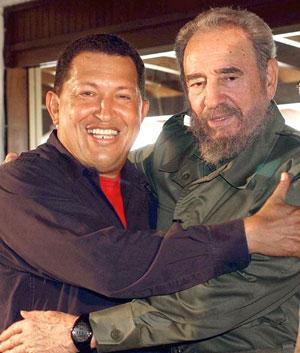How has Fidel managed to stay in power for so long?: That is one of the most typical questions I get from people who do not follow closely the situation in Cuba and are unfamiliar with Cuban history. Many of them believe the explanation is complex, but in reality, it is quite simple. When you are kept in abject poverty and misery, wondering where your next meal will come from and how in the world you will be able to find shoes for your children, the last thing on your mind is politics. As long as the people are kept weak in poverty, it takes much less effort to control them.
This is a lesson the Cuban people have learned all too well. And it is a lesson the people in Latin America unfortunate enough to have Fidel’s revolution exported to their country are learning as well. Ecuador, Bolivia, and Nicaragua are but a few examples, but Venezuela provides the most vivid exemplification.
On his blog Enrisco, Enrique del Risco shares the “technique” to subdue and control a population as explained to a former Venezuelan general by the country’s Chavista Economics and Finance Minister (my translation):
It’s all about Technique
According to former general Guaicapuro Lameda, who is also the former president of PDVSA (the state-owned company that controls the production of petroleum in Venezuela), Jorge Giordani, the current minister of Economy and Finances, years ago responded to his complaints that Chavezism was incapable of generating wealth and told him this :
“Look, General, you still don’t understand the revolution. Let me explain it to you: This revolution proposes to make a cultural change in the country, to change the way people think and live, and these changes can only be forced from the seat of power. Therefore, the first thing we have to do is stay in power in order to make those changes. The poor people have given us the political stage: they are the ones who vote for us so that is why we’re always talking about defending the poor. THE POOR PEOPLE WILL HAVE TO STAY POOR, WE NEED THEM THAT WAY, until we achieve the cultural transformation. Later, we can talk about economies and the generation and distribution of wealth. In the meantime, we have to keep them poor and hopeful […] this is about a cultural change and that takes at least three generations to carry out. The adults will resist it and cling to the past; the young people will live in it and become accustomed to it, and the children will learn it and make it their own. It will take a minimum of 30 years.”
And when he went to Cuba, Fidel Castro told him not to worry about the aid Venezuela would give Cuba:“To maintain ourselves we need about $4 billion dollars annually. More than that is a ‘nuisance,’ the people will begin living the good life and that will end the public discourse on poverty.”


Castro is a master of deceiving and has intentionally kept his people in slavery. This article hits the nail on the head. He has been stealing from his government ran agencies for years and putting it away in his secret bank account around the world. Most Cubans in Cuba under 50, have been brain washed to think that this is the only way of life. It is a pity what this devil had done to Cuba.
Yes, it’s ultimately all about staying in power. Everything else is secondary. The poor, like the eternal “public discourse” about poverty, are simply tools to be used to get and maintain power; the poor’s welfare is a moot point, a cynical rhetorical device. The Castro machine did not ruin what had been a prosperous and thriving country by accident or mistake; it meant to ruin it, so that the populace would remain dependent and perpetually distracted by the endless struggle to meet its basic needs. After all, the much-vaunted revolution wasn’t for the masses, but for the benefit of a ruling class that had every intention of retaining power in perpetuity. In other words, the revolution was a monumental con.
Yes, Hugo was an ape. And yes, Fidel totally used him, the whole time thinking to himself “Pero mira que este indio es comemierda!”
Note the facial expressions in that photo. Hugo is delighted, like a kid in a candy store. Fidel is jaded (very) and simply going through the requisite motions, playing a part. It’s amazing how badly people can fool themselves when they want to believe in lies.
I wrote a review of Learning to Die in Miami and every once in a while someone comments on it and if anything nice is said about my review a troll comes out and has to have the last word. I call these people the what about Batista crowd.
This one’s big genius line is if Castro is so bad why has there been no revolution?
Who are these people? Is Castro paying them? What is their reason for their fanaticism?
Honey, you call them the “what about Batista crowd,” but we have a much simpler name for them: Los comemierdas.
Meanwhile here in the States, the number of people on welfare increases. It used to be that people would work two or three menial jobs rather than that, and do without.People get the government they deserve; their children and future generations pay the price.